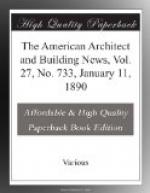One hundred Royalls,
One hundred Pound Powder,
Two hundred fathom of white Wampum,
One hundred Barrs of lead,
One hundred fathom of black Wampum,
Thirty tobacco boxes, ten holl adzes,
Thirty Gunns, twenty Blankets,
Forty fathom of Duffils,
Twenty fathom of stroudwater Cloth,
Thirty Kittles, forty Hatchets,
Forty Hornes, forty Shirts,
Forty pair stockins,
Twelve coates of B.C.,
Ten drawing Knives,
Forty earthen Juggs,
Forty Bottles, Fouer ankers Rum,
Forty Knives, ten halfe Vatts Beere,
Two hundred tobacco pipes,
Eighty pound tobacco.
The purchasers were also to pay Governor Dongan six bushels of good and merchantable winter wheat every year. The deed is recorded at Albany in Vol. 5 of the Book of Patents.
Before 1685 Gulian Verplanck died, leaving minor children, and settlements on his portion of the land were thus postponed. Divisions of the estate were made in 1708, in 1722, and again in 1740. It is not accurately known when the Homestead, the present low Dutch farm-house was built, but we know that it stood where it now stands, before the Revolutionary War, and the date commonly assigned to the building is a little before 1740.
The house stands on a bluff overlooking the Hudson, about a mile and one-half north of Fishkill Landing. It is one-story and one-half high, of stone, plastered. The gambrel roof is shingled, descends low and has dormer windows. The house has always been occupied and is in excellent preservation. Baron Steuben chose it for his headquarters, no doubt for its nearness to Washington’s headquarters across the river, and for the beauty and charm of the situation. It is made still further famous by the fact that under its roof was organized in 1783 the Society of the Cincinnati. The room then used is on the right of the hall, and is carefully preserved. In fancy we can picture the assembly of officers grouped about Washington, in that west room overlooking the river, pledging themselves to preserve the memories of the years during which they had struggled for their country’s being.
The whole neighborhood, especially the village of Fishkill which was the principal settlement in the county at that date, has many revolutionary associations. The interior army route to Boston passed through the village; this was a depot of army stores, and workshops and hospitals were established. Here was forged the sword of Washington, now in the keeping of the United States Government, and exhibited in the late Centennial collection. It is marked with the maker’s name, J. Bailey, Fishkill.
The New York Legislature, retiring before the approach of the British, after the evacuation of the city, came at last to Fishkill, and here the constitution of the State was printed, in 1777, on the press of Samuel Loundon, the first book, Lossing says, ever printed in the State.




